I am interested in developing fundamental understanding of physical processes at the intersection of microscale fluid and solid mechanics, soft condensed matter, and biology. Research topics are described below and in the links.
I gratefully acknowledge funding from the National Science Foundation and National Institutes of Health. (Awards CBET-0967510, CBET-1067798, CBET-CAREER-1252182/1651031, DMR-1307497/1650970, CMMI-1435652, CMMI-1760642, CBET-1805847, NIH 1R01GM131408, CMMI-2027417 which have supported aspects of projects indicated below.)
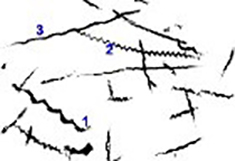 Microorganisms are capable of propulsion in the viscosity-dominated low Reynolds number regime. How does the hydrodynamics of microbial locomotion affect their biological processes and ecological roles? [CBET-CAREER-1252182]
Image caption: Helical trajectories of swimming Bacillus subtilis.
Microorganisms are capable of propulsion in the viscosity-dominated low Reynolds number regime. How does the hydrodynamics of microbial locomotion affect their biological processes and ecological roles? [CBET-CAREER-1252182]
Image caption: Helical trajectories of swimming Bacillus subtilis.
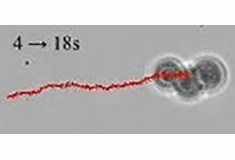 How can we design artificial microswimmers capable of low Reynolds number propulsion? Such microswimmers or microrobots may have applications in microfabrication, in situ sensing and diagnostics, drug delivery, and microsurgery. [CBET-1067798, CMMI-1435652]
Image caption: Achiral magnetically rotated microswimmer.
How can we design artificial microswimmers capable of low Reynolds number propulsion? Such microswimmers or microrobots may have applications in microfabrication, in situ sensing and diagnostics, drug delivery, and microsurgery. [CBET-1067798, CMMI-1435652]
Image caption: Achiral magnetically rotated microswimmer.
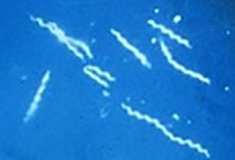 The basic principles of how microorganisms swim in Newtonian fluids are well understood. However, it is quite common that microorganisms must navigate complex media in their natural biological environments. What is different when swimmers are in non-Newtonian fluids and gels? [CBET-CAREER-1252182]
Image caption: Spirochetes burrow into tissue to infect it. (B. burgdorferi, CDC image)
The basic principles of how microorganisms swim in Newtonian fluids are well understood. However, it is quite common that microorganisms must navigate complex media in their natural biological environments. What is different when swimmers are in non-Newtonian fluids and gels? [CBET-CAREER-1252182]
Image caption: Spirochetes burrow into tissue to infect it. (B. burgdorferi, CDC image)
Like left and right hands, chiral objects are not superimposable upon their mirror images. Chirality is ubiquitous in biology. Amino acids, the building blocks of proteins, are chiral, and hence all proteins are chiral. At a larger scale, bacteria often have chiral morphology, such as the helical flagella which propel many swimming microorganisms. What happens when chirality interacts with non-uniform flows? [CBET-0967510, CBET-1067798]
Image caption: Pair of chiral particles related by mirror symmetry.
The mechanical properties of many biological materials are determined by filaments and filamentous networks. How do the mechanical properties of these materials inform biological function, and can they be used to engineer new materials? [DMR-1307497]
Image caption: Flagella patterned to a surface form a biomaterial that take advantage of flagellar response for sensing and autonomous actuation.
As a Ph.D. student, my graduate work was on the physics of strongly correlated electron systems, including high-temperature superconducting materials and mesoscopic superconductivity. 




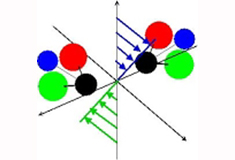 Chiral Particles and Microorganisms in Flows
Chiral Particles and Microorganisms in Flows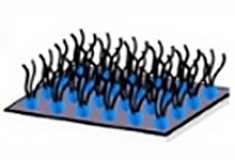 Mechanics of Complex Biomaterials
Mechanics of Complex Biomaterials